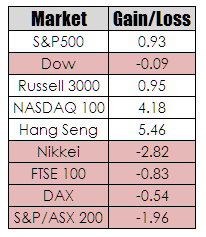In line with the notion of January predicts the direction if the not the quanta of the year ahead here is a rundown of the January gains or losses for various markets. Make of it what you will….if anything…..
What is more interesting to me is what I perceive to be a dislocation between perception and reality. The market commentary I have had the misfortune to hear lately has spoken about the sudden rise in volatility in the market. The basis for this judgement has been a bit of a jump in the VIX over the last trading period. Of course completely ignoring the fact that the VIX has been meandering around at historically low levels for the past three months. It is worth noting what the VIX measures before assigning any weight to it.
According to CBOE’s marketing blurb –
The CBOE Volatility Index® (VIX® Index) is a leading measure of market expectations of near-term volatility conveyed by S&P 500 Index (SPX) option prices. With the introduction of the VIX® Index in 1993, followed by the launch of trading of VIX futures at CBOE Futures Exchange (CFE) in 2004 and VIX options at CBOE in 2006, there has been a growing acceptance of trading VIX and VIX-linked products as risk management tools.
VIX options and futures enable investors to trade volatility independent of the direction or the level of stock prices. Whether an investor’s outlook on the market is bullish, bearish or somewhere in between — VIX options and futures can provide the ability to diversify a portfolio or hedge, mitigate or capitalize on broad market volatility.
That is the VIX is a measure of other peoples perception, granted this is arrived at by looking at changes in volatility expectations implicit within options pricing. So the VIX really doesn’t measure market expectations and hence one of the major criticisms I have of it. It is simpler to default to actually looking at what the current historical volatility of an instrument is.
This is the Dow with a simple 15 day historical volatility plotted and as you can see since July of last year the peaks in volatility have been dropping and the post electio bump has been a time of very stable volatility.







